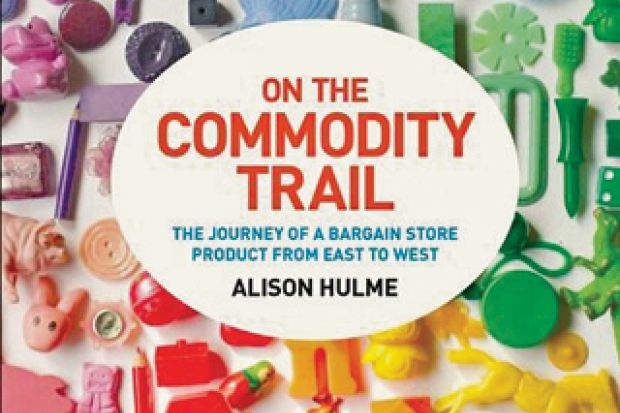Let’s take a journey into the secret life of things. This journey connects people, places and objects in ways that are scarcely imaginable and reveals how some of the world’s most mundane objects (garden gnomes, plastic flowers) and its most marginal spaces (container ports, rubbish dumps) are, on closer inspection, paradigmatic of contemporary capitalism where value, price and thrift coalesce under the global mantra of “the bargain”.
This is the remarkable journey that Alison Hulme recounts in her pursuit of the meanings and makers behind everyday objects. In tracing the fates of low-cost commodities, she reveals with great acuity just how challenging it is to follow their circuitous, chaotic and opaque stories. The global traffic in cheap goods is characterised by constant rupture, dislocation and flux. In a remarkable piece of geographical detective work, Hulme brings a series of neglected spaces into simultaneous view in order to reveal how austerity, precarity and the “race to the bottom” have combined to reshape contemporary consumption. As annual turnover at the UK’s Poundland chain passes the £1 billion mark, it appears that low-end commodity chains are the great survivors of capitalism.
On the Commodity Trail weaves a tapestry of inter-connected spaces through which the global traffic in cheap goods flows. We travel from the waste-pickers of Shanghai’s municipal dump to the global commodity city of Yiwu, which is dedicated almost entirely to the sale of thousands of tiny products; then back to Shanghai, from whose port the world’s largest shipping containers transport bargain consumption to the West; and on to the discount stores of our high streets and into the homes of consumers who display cheap objects with pride – they have tricked the market, outwitted it; beaten the system by buying wonderful trinkets for pennies. In a curious caricature of the Silk Route, we trace the trajectory of the cheap goods that lure us into buying ever more, as shoppers are enticed by the thrill of the bargain and its instant gratification. When “Everything is £1”, the consumer is invested with agency and freedom. The contradictions of consumption are dissipated in the space of the bargain store, where one can spend but not overspend, desire and acquire, meet needs without greed.
Here is commodity fetishism thrown into sharp relief, where acquiring a bargain is far removed from concerns about supply chains, exploitative labour conditions or durability. It is treasure-hunt consumption, predicated on the hedonistic thrill of the moment. For some it is born of economic necessity under conditions of poverty and precarity, and represents one of the few ways in which participation in consumer society is possible. For others, the “pound store” offers a thrill and a moment of immersive pleasure: back at her home, Hulme details, “a woman smiles as she decides upon a home for ‘Gerald’ the garden gnome, by the heather on her rockery”.
Here we see with remarkable clarity that objects in people’s lives have meanings regardless of market price. Value, it seems, continues to reside in the most unlikely places, and unlocking the secret of value reveals the fundamental importance of object-subject attachment. Our things are meaningful because of the relationships we have with them, above and beyond the market.
On the Commodity Trail: The Journey of a Bargain Store Product from East to West
By Alison Hulme
Bloomsbury, 176pp, £65.00 and £19.99
ISBN 9781472572868 and 2851
Published 26 February 2015
Register to continue
Why register?
- Registration is free and only takes a moment
- Once registered, you can read 3 articles a month
- Sign up for our newsletter
Subscribe
Or subscribe for unlimited access to:
- Unlimited access to news, views, insights & reviews
- Digital editions
- Digital access to THE’s university and college rankings analysis
Already registered or a current subscriber? Login





